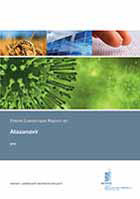Patent Landscape Report on Atazanavir
Publication year: 2011
DOI: English

This patent landscape report is dedicated to Atazanavir – an antiretroviral drug used to treat HIV infection and AIDS. A major objective of this report is to examine the evolution of the patent environment protecting Atazanavir from the first filing of this compound to the present filings. The second objective is to provide insight into best practice for probing the patent literature in the pharmaceutical area. Because combination therapies involving more than one drug are such an integral part of pharmaceutical development, and because that is especially true for AIDS therapies, a separate chapter of the report focuses on combinations.
- Topic: Public health
- Cooperation partners: Medicines Patent Pool; UNITAID
Atazanavir is an antiretroviral drug from the protease inhibitor class used to treat HIV infection and AIDS. Atazanavir is included in the WHO Model List of Essential Medicines (EML).
A major objective of this report is to examine the evolution of the patent environment protecting Atazanavir from the first filing of this compound in July 1995 by Novartis (then CIBA-GEIGY) (US5753652A) to the present filings in which additional patent families attempt to protect subsequent innovations to the compound, variants and derivatives, combinations with other chemicals, methods of production, further therapeutic indications, etc.
The second objective of the project is to provide insight into best practice for probing the patent literature in the pharmaceutical area, i.e. for assembling collections of published patent applications through which drug development can be reliably studied. These practices include various names for the substance that evolve over the pre-clinical and clinical phases of drug development, the utilization of indexing systems (non-proprietary or proprietary), and harnessing the expert-created system of technical linkages between patents – i.e. the references (citations) between applications or patents and the art that preceded them in time.
Once the collection process is laid out, the report goes on to cover various analytic approaches to probe the collection for nuggets of intelligence. It separates the activity of the developer of Atazanavir (Novartis and its licensee Bristol-Myers Squibb) from activity of other entities, and compares the two across a timeline. It identifies the inventions that reference standard phases of drug development including: composition discovery, establishing biological targets (pathway modulation effects), developing synthetic methods, formulating for treatment, describing best disease indications, investigating combinations, improving synthesis, and broadening uses.
Because combination therapies involving more than one drug are such an integral part of pharmaceutical development, and because that is especially true for AIDS therapies, a separate chapter of the report focuses on combinations.